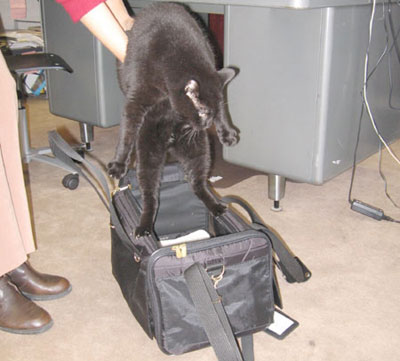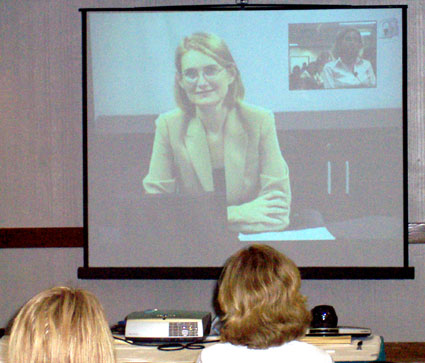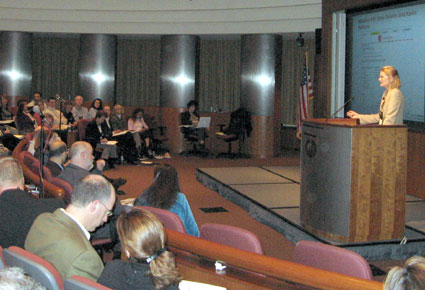By Anne Holland, President
This morning as you read this, I'll be standing in front of a podium at our live "in person" Summit in Boston. And I'll be worrying a lot about ... picking my nose in public.
It's incredibly stupid. Years ago I read an interview where rock star Sting said the giant video screens at concerts make him nervous he'll slip up, pick his nose and be horribly embarrassed in front of thousands of people.
For some reason that stuck with me, and although I am *not* a nose picker, that's the dumb thing I find myself fretting about at conferences.
Luckily for my stress-level, this year I've mainly presented live at virtual events such as webinars and teleconferences. Unfortunately, even in the virtual event world, opportunities for being a dork abound.
Here are my top 10 tips for any of you who also have to give "virtual" speeches: (Note: Looking for photos? Scroll to the bottom).
#1. Nobody can see your arms waving
I'm the queen of gesticulation -- waving my arms with excitement as I speak. (And all too frequently knocking over water glasses in the process, but that's another story.)
If you're doing a webinar or telephone event, nobody can see you. On the other hand, they can see their co-workers, phone call-waiting flashes and incoming email. Your voice has to be so compelling that it carries them away from their office distractions.
So I've learned to try to take the energy away from my arms and put it more into my voice.
#2. Alternate male and female speakers
Nothing's worse than presenting by yourself for 60 minutes straight. You'll end up exhausted and worried everyone listening was bored by that endless monologue no matter how peppy it was.
Get yourself a co-host. Better yet, get yourself a co-host of the opposite sex. That way the overt change in voice keeps your listeners' attention.
#3. Don't trust your co-host to show up
On three occasions in the past six months, whoever was co-hosting with me failed to make the date. Once I didn't know until after the speech had started. Ack!
The problem is, once you get used to having a co-host around, you can get a bit lazy. You only have to cover, say 35 minutes, and count on him for the rest. Suddenly there you are with a whopping 60 minutes of air time and only 35 minutes of something to say.
I've learned two lessons: keep written notes on what my co-host is going to say that's not on the slides. Also, don't be afraid to end a little early. Better to give folks a quick-but-juicy presentation than have streeeeetched it out and bored them to death.
#4. Keep printouts of your presentation on hand
Invariably your office Web connection will go down someday while you're in the middle of giving a speech. Nothing is worse than staring at a blank screen while inanely talking, hoping like crazy you'll remember off the top of your head what the next five slides contain.
Keep a printed out copy of the presentation. Plus, arrange a codeword or secret phrase with a co-presenter or moderator to let them know you can't move the slides along anymore (if you were in charge of that).
#5. Post a PDF copy of the presentation online *beforehand*
Also invariably a few attendees will not be able to see the slides being presented on the screen (almost no matter what system you're using).
I've learned to create a PDF of the presentation and have our production folks post it to a handy page online. Then I try to make an announcement in the first five minutes, and also on the half hour, letting folks know they should "zap off an email to customer service for your slides if you can't see them."
We usually get a handful of takers, so it's well worth the trouble.
#6. Never start a presentation "on the hour"
Watching the live attendee count can be unnerving. One second you have 177 people, the next 173 and you think, 'My golly, what did I say?!" So, I try to ignore that part of the webinar screen.
However, the live counts have taught me never ever to start a presentation until at least two minutes past the hour. Just like meetings in real life, most people don't show up on time.
#7. Don't go over your officially allotted time
Incredibly ignorant of me -- I used to think if I went over the official time by say 10 minutes people would not mind because they were getting extra information. More value - right? Nope.
Most marketers are too busy and heavily scheduled to enjoy meetings that run overtime, no matter how useful the information being presented is. It's not respectful to run long and I'm trying my darndest never to do it again.
BTW: Always rehearse an entire speech live and time it before you give it for real.
I've found the less experienced my co-host is, the more likely they'll want to pack in way too many slides and info for the time allotted. Rule of thumb -- one slide for every two to four minutes is best. More often means your content is too "lite" or your speech is too jammed.
#8. Resist using live chat or Q&A during the main speech
Webinar companies include ongoing Q&A and live chat with the presentation because the tech's not that hard to build. However, just because it's possible to do, doesn't mean it's smart.
No one can speak effectively and compellingly and answer off-the-cuff questions in the non-Q&A section of their speech. You wind up sounding disjointed and flustered. Plus, if you wait until your co-host is speaking to dash off written answers to folks, it's rude and disrespectful of his/her time in front of the audience.
#9. The videoconferencing dork factor
I recently did my first videoconference. Super neat. I was sitting in a conference room in Boston, presenting live to a group in Arizona. They stuck a video camera on the table at the front of their room so I could "see" everyone, and vice versa.
Thing is, the camera sits on the table... so your perspective as a viewer is of being a tiny little person looking up at these great huge creatures looming above the table. And vice versa.
Also, sometimes the slight time lag between what you say and what they hear can throw you off. I'd crack a joke, nobody would laugh, then I'd panic thinking "Stop making lame jokes!" and try to act more serious, and then a second later everyone would start laughing. You wind up feeling dorky twice in a row.
#10. Don't forget to move the cat
We have a company policy that everyone can bring their pets to work (yes, we have a No-Pets room where allergic folks are isolated for their comfort and safety).
Anyway, my old cat Pete lives in my office. His hobbies are eating, sleeping, sleeping and sleeping. And, sometimes he likes to take a nap.
You'd never know he was there. Except the minute I get on the phone to do a webinar or teleseminar. Then he erupts into a frenzy of loud meows. Unceasingly. For the entire hour.
So I purchased a fleece-lined animal carrier bag called, no joke, a Sherpa. Prior to each event, I stuff Pete into the Sherpa and off he goes down the hall to spend the next hour making the lives of the folks in our service department a living nightmare.
If you call in to our 800 line the next time I'm giving a virtual speech, you'll be able to hear Pete yowling away in the background.
Anyway, today Pete's happily catching up on some much needed zzzzs while I pontificate in person at the Summit. While *not* picking my nose, thank you very much!
MarketingSherpa virtual events: behind-the-scenes 1. Dorky action shot -- during a webinar, no one can see you gesticulating

2. Pete the office cat goes into his Sherpa holder before a teleconference

3. When you give a videoconference, you think you're about 3 inches tall... while in reality you're looming over the audience.

4. Here I am *not* picking my nose at our B-to-B Lead Gen Summit on Monday:














